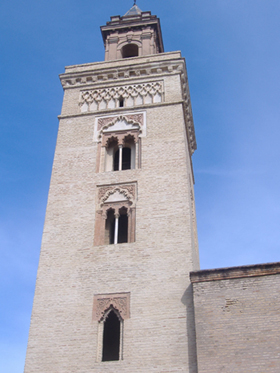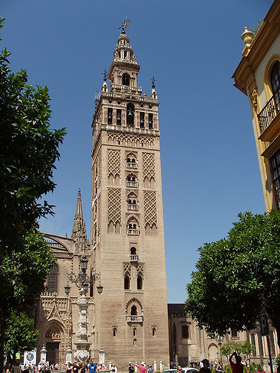- Home
- History of Seville
-
Muslim Period
Historoy of Seville
Isbiliya, Arab Sevoññe-
The end of the visigoth empire coincides with the arrival of power of the King Don Rodrigo. The battle in the lagoon of Janda takes place in 711 A.D., called the Battle of Guadalete. Organizing the arab advance, Tarik goes to Toledo through Málaga and Cordova and Muza leader Ibn Nusayr and is once again re-named, this time with the name Isbiliya, (the common people pronounced it Shbila, from where the present name Sevilla comes). And the arabs also call the "Rio Grande" Guadalquivir.


Isbiliya enjoyed a great cultural wealth; even though dependent upon the Califate of Cordova, Isbiliya was one of the most important cities of Al-Andalus, (the arab name for Andalucía). Mosques were built and still exist today, although converted into christian church bell towers; for example, Santa Catalina, San Gil, San Andrés, San Marcos, etc.
The fall of the Cordovan Califate in 1013-1035 A.D. promotes the appearance of the Kingdoms of Taifas, one of which has its headquarters in Isbiliya. At that time Isbiliya enjoyed a period of splendor and hegemony over the rest of the Taifa Kingdoms under the reign of Al Mutamid (son of Ben Abbas), a cultured king, and a great lover of art and literature. Under his reign Isbiliya becomes a cultural center of great magnitude; it welcomes great poets such as Aben Amar, Abd Al Chalil, great music schools are created, etc. In addition we must emphasize its military habilities and the good government policy of the Mutamid.
However, to restrain the expansion of Alfonso VI, son-in-law of Al-Mutamid by marriageto his daughter Zaida, (Alfonso VI was the king of Castilla and Leon) the muslim kings of Badajoz, Granada and Isbiliya agree to ask for exterior aid from the african Bereberes, the Almorávides. In the end the Almorávides prove stronger than the Taifa Kingdoms, overtake Isbiliya in 1901 A.D. and they put Al Mutamid into exile and to prison in Tanger.
Social intolerance and extreme religious rigidity imposed by this dynasty upset the people who begin to organize independent movements and at the same time there is an exodus of Mudéjares towards the north. All of this incites the arrival of the Almohades, who disembark in Cádiz in 1146 A.D..
The Almohades designate Isbiliya the administrative capital of Al-Andalus. Days of well-being and prosperity, intermingled with days of restlessness due to frequent castillian incursions in the territory and the periodic flooding of the Guadalquivir river. However, this does not prevent tha Almohades from developing an important construction program, (for example, palaces, mosques, the Giralda, the Golden Tower, etc.) in addition a great mosque was built where today you have the imposing Cathedralas well as the construction of the Bridge of Barcas, with the purpose of joining the city with the Aljarafe and the district of Triana.
After the victory of the Christians at Navas of Tolosa (1212 A.D.), the Almohaden Empire suffered remarkably; towards the year 1220 A.D. its power reaches its total decline. This is the period of the Golden Tower and the repair of the roman walls for defensive aims.












